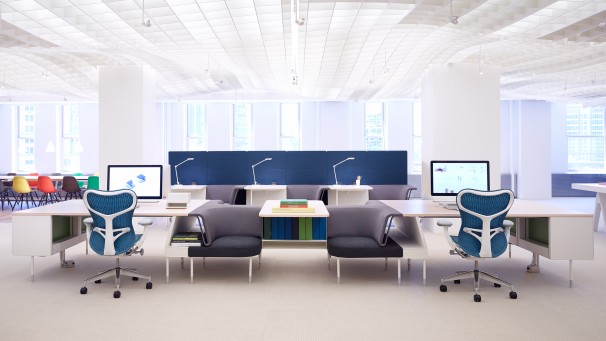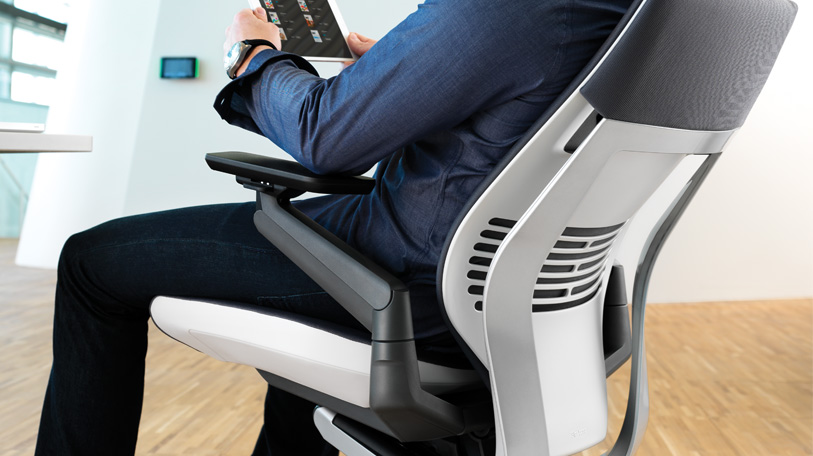
Office manufacturers are starting to respond to the demand for collaborative workspaces by tearing down cubicle walls and offering innovative new visions for workspace, like Herman Miller's Public Office Landscape. With the economy picking up slightly, furniture manufacturers are slowly getting back into gear.
Any office furniture retailer will you that an overflowing warehouse is a sign of an unhealthy economy. When companies are pinching pennies and/or downsizing, new office furniture is often one of the first items hacked off the budget. But just as a quiet showroom is an indicator of uncertainty, a pickup in sales hints that things might finally be starting to pick up again.
When companies are buying more furniture, manufacturing follows suit.
"The office furniture industry is very, very active and aggressive right now in recapitalizing their factories and challenging themselves technically and innovatively," Steve Waltman, vice president of marketing and communications at Stiles Machinery Inc. in Grand Rapids told Crain's Detroit Business.
As for some numbers, a survey of the office furniture industry trends found that the index for capital expenditures is expanding as is the index for tooling. But while these areas are growing modestly, the survey also found that outlook of furniture industry executives has dropped since 2012 from 59.2 to 54.73.
Herman Miller Inc. President and CEO Brian Walker told Crain's that he expected growth to be reasonable in the coming years.
"It's not like it's a rocket ship or hockey-stick growth. It's certainly way better than a few years ago when we were all feeling the down side," he said.
In May, the Business and Institutional Furniture Manufacturers Association projected that shipments would grow by 2.1 percent in 2013 to $9.5 billion and by 7.2 percent in 2014.
This news doesn't mean it's time to pop the cork on the Cristal just yet, but it might mean we can all have a little sigh of relief. What's more, changes in the style of workspaces companies need for their offices should also spur innovation, production and sales.
The advent of smartphones and tablets has created demand for more flexible workspaces in recent years. Furniture manufacturers have taken note and are now exploring new designs that step away from the cubicle walls they've been selling for decades.
Evidence of this evolving office design could be seen at the annual NeoCon Convention in Chicago in June.
Dimmensional Innovations noted some of the biggest trends spotted at the show in a recent article. Among them:
Sustainable materials: More than 60 exhibitors showcased green products, with everything from carpet composed of old fishing nets to wall coverings made from sugar cane. Since both consumers and companies are demanding more sustainable products, we're probably just starting to see the innovations in this niche. Collaborative workspaces: Offices have been moving away from the infamous Dilbert-style cubicles for years, but it's only been recently that manufacturers have really started imagining what future office spaces might look like. The buzzword at NeoCon seemed to be "collaboration" as a variety of concepts for workspaces that encouraged conversation and the exchange of ideas took the form of open-seating lounges clustered around monitors or large tables with embedded monitors; anything that invited employees to share information in a more informal and holistic manner.

The Gesture chair from Steelcase was designed with mobile technology in mind.
High-tech furniture: As mentioned earlier, new technology has been a tremendous driver for furniture design. Many NeoCon exhibitors found ways to incorporate technology into furniture design either by simply adding an outlet to plug in devices or by taking it a step further like the Slate Table by OFS and making the piece itself part of a video conferencing experience. Beyond looking at how to add technology to furniture, manufacturers have tried to adapt furniture to accommodate how users interact with their technology. For instance, Steelcase researched postures people sat in while using their mobile devices and incorporated that research into its new Gesture chair. With all these new innovations on the horizon, once the economy shows even stronger recovery, expect to see major shifts in what's hitting showroom floors. Say goodbye to clunky, boxy systems furniture and hello to open, airy and technology friendly workspaces.





